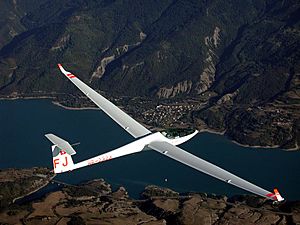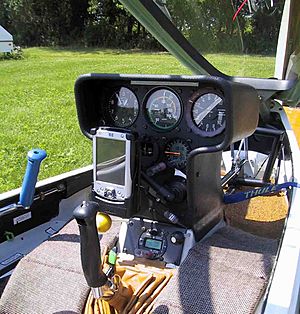Glider facts for kids

Gliders are aircraft that fly without a motor. They are like airplanes, but they don't have an engine to push them forward. Pilots control gliders using special sticks, much like in a regular plane. Some gliders are built for just one person, while others can carry two. In two-seater gliders, both pilots have their own control sticks. Every glider has seats for the pilots to sit in comfortably.
Contents
What Makes Gliders Fly?
Soaring High with Sailplanes
Some gliders are called 'sailplanes'. They have very long wings. These long wings help them lose height very slowly. Imagine a bird gliding without flapping its wings – that's what a sailplane does!
Pilots can make gliders climb higher by finding areas where the air is moving upwards faster than the glider is coming down. This is called soaring. It's like riding an invisible elevator in the sky! Good pilots are experts at finding these rising air currents. They can travel hundreds of kilometers each day just by using the natural movement of the air. Some pilots even race each other, while others simply fly for fun.
Getting Into the Air
Gliders can't take off by themselves because they don't have engines. They need a little help to get started. Usually, another aircraft with a motor pulls the glider into the air. This is like a tow truck pulling a car. Sometimes, a motor on the ground can also pull the glider up using a long cable. Once they are high enough, the glider disconnects and flies freely.
Other Types of Gliders
Besides traditional gliders, there are two other cool types:
- Hang-gliders: These gliders have a frame that gives their wings shape. However, they don't have seats or control sticks like regular gliders. The pilot hangs underneath the wing and controls it by shifting their body weight.
- Paragliders: The wings of paragliders look more like large parachutes. They don't have a solid frame to hold their shape. Instead, the air pressure keeps them inflated.
Both hang-gliders and paragliders are often launched from high places, like the tops of hills or cliffs. This gives them a good starting height to catch the air currents.
See also
 In Spanish: Glider para niños
In Spanish: Glider para niños


